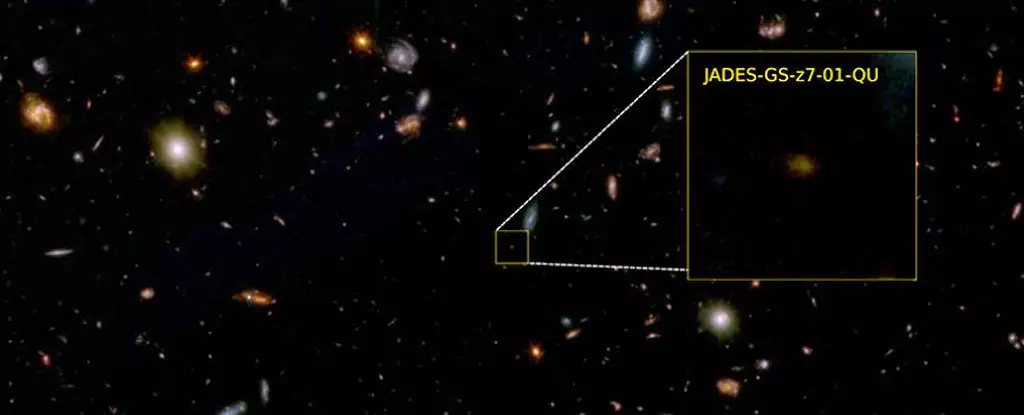In the vast and mysterious universe, there lies a dead galaxy that defies the common expectations of cosmological processes. The galaxy JADES-GS-z7-01-QU, discovered by an international team of astronomers during a JWST observation, presents a puzzling case of a galaxy that ceased star formation at an incredibly young age. In a universe that was only 700 million years old, this galaxy already exhibited signs of being ‘quenched,’ devoid of the ongoing process of creating new stars. This anomaly challenges our understanding of early galactic evolution and raises questions about the mechanisms that govern star formation in the cosmos.
The Curious Case of Premature Star Formation Quenching
Typically, the formation of stars in galaxies is a gradual and continuous process that unfolds over billions of years as gas clouds collapse to give birth to new celestial bodies. However, the case of JADES-GS-z7-01-QU paints a different picture. This young galaxy experienced an intense burst of star formation shortly after its inception, blazing with stellar activity for an estimated 30 to 90 million years before abruptly halting its star-forming endeavors. The sudden cessation of star birth in this galaxy challenges the conventional wisdom of cosmologists and prompts a deeper investigation into the factors that might have led to this premature quenching.
One possible explanation for the cessation of star formation in JADES-GS-z7-01-QU is the depletion of gas, the essential element required for the birth of new stars. It is plausible that a supermassive black hole at the galaxy’s core devoured much of the available gas, hindering the star-forming process. Alternatively, the rapid pace of star formation in the early universe might have exhausted the gas reservoir of the galaxy, forcing it into a dormant state. These hypotheses point to the complex interplay between black holes, stellar winds, and galactic dynamics in shaping the evolutionary trajectory of galaxies.
As astronomers delve deeper into the enigma of JADES-GS-z7-01-QU, new questions and possibilities emerge. The quest to understand why galaxies cease forming stars and whether they can reignite this process opens up exciting avenues for further exploration. By leveraging advanced technologies like the James Webb Space Telescope (JWST), researchers hope to identify more galaxies in the early universe that exhibit similar quenched states. These discoveries will shed light on the mechanisms that govern cosmic evolution and offer insights into the fate of galaxies in the vast expanse of space.
The discovery of JADES-GS-z7-01-QU challenges existing cosmological models based on the modern universe. It highlights the need to reevaluate our understanding of early galactic evolution and revise our models to account for the rapid quenching of star formation observed in this young galaxy. By incorporating data from distant and ancient galaxies, astronomers can refine their theories and gain a more comprehensive view of the processes that drive cosmic evolution.
The dead galaxy JADES-GS-z7-01-QU offers a glimpse into the complex and dynamic nature of galactic evolution in the early universe. Its premature cessation of star formation raises intriguing questions about the mechanisms that govern cosmic processes and challenges our current understanding of galactic dynamics. Through continued exploration and observation, astronomers aim to unravel the mysteries of this enigmatic galaxy and gain valuable insights into the evolution of galaxies in the vast tapestry of the cosmos.


Leave a Reply